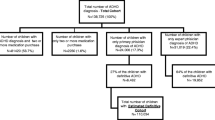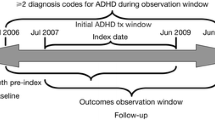Abstract
Objective: To use a single national data source to discern trends in the prevalence of office-based visits resulting in a diagnosis of attention deficit hyperactivity disorder (ADHD) among girls, and trends in the prescribing of stimulant pharmacotherapy (including methylphenidate) for its treatment in the US.
Methods: Data from the US National Ambulatory Medical Care Survey were utilised for this analysis. The number and rate of office-based physician visits resulting in a diagnosis of ADHD (International Classification of Diseases, 9th Revision, Clinical Modification code 314.00 or 314.01) were discerned from the beginning of 1990 to the end of 1998, for children aged 5 to 18 years. Gender-specific trend analyses were conducted using four time intervals: 1991 to 1992, 1993 to 1994, 1995 to 1996, and 1997 to 1998.
Results: The estimated number of office-based visits documenting a diagnosis of ADHD among children increased from 947 208 in 1990 to 3 234 180 in 1998. The rate of office-based visits documenting a diagnosis of ADHD among children increased from 19.4 per 1000 of the US population aged 5 to 18 years in 1990 to 59.0 per 1000 in 1998, a 3-fold increase (p < 0.05). The annualised mean number of office-based visits documenting a diagnosis of ADHD among girls tripled between 1991 to 1992 and 1997 to 1998 (from 296 389 to 886 798), whereas the number for boys increased 2.2-fold (from 1 006 243 to 2 200 021). The US population-adjusted rate of office-based visits documenting a diagnosis of ADHD among girls increased 2.7-fold between 1991 to 1992 and 1997 to 1998 (from 12.3 per 1000 girls to 33.4 per 1000; p < 0.05), whereas the rate among boys doubled (from 39.5 per 1000 boys to 78.7 per 1000; p < 0.05). Documentation of a diagnosis of ADHD and the prescribing of stimulant pharmacotherapy increased 2.8-fold for girls, from 7.5 per 1000 girls in 1991 to 1992 to 21.1 per 1000 in 1997 to 1998 (p < 0.05), as compared with a 2.2-fold increase among boys (from 25.5 per 1000 boys to 57.0 per 1000; p < 0.05).
Conclusion: Over the time frame 1990 to 1998, the rate of ADHD as well as the prescribing of stimulant medications for its treatment increased significantly among children aged 5 to 18 years. Between 1991 to 1992 and 1997 to 1998, the increased rate of diagnosis of ADHD among girls contributed to the overall upward trend. The rapidly increasing rate of ADHD among girls, and the prolonged nature of the disorder, represent significant public health problems. There exists a need for additional research examining both the aetiology and treatment of ADHD by gender.




Similar content being viewed by others
References
American Psychiatric Association. Diagnostic and statistical manual of mental disorders. 4th ed. Washington, DC: American Psychiatric Association, 1994: 78–85
Goldman LS, Genel M, Bezman RJ, et al. Diagnosis and treatment of attention-deficit/hyperactivity disorder in children and adolescents. JAMA 1998; 279: 1100–7
Gingerich KJ, Turnock P, Liftin JK, et al. Diversity and attention deficit hyperactivity disorder. J Clin Psychol 1998; 54: 415–26
Berry CA, Shaywitz SE, Shaywitz BA. Girls with attention deficit disorder: a silent minority? A report on behavioral and cognitive characteristics. Pediatrics 1985; 76: 801–9
Baumgaertel A, Wolraich ML, Dietrich M. Comparison of diagnostic criteria for attention deficit disorders in a German elementary school sample. J Am Acad Child Adolesc Psychiatry 1995; 34: 629–38
Cantwell DP. Attention deficit disorder: a review of the past 10 years. J Am Acad Child Adolesc Psychiatry 1996; 35: 978–87
Wolraich ML, Hannah JN, Pinnock TY, et al. Comparison of diagnostic criteria for attention-deficit hyperactivity disorder in a county-wide sample. J Am Acad Child Adolesc Psychiatry 1996; 35: 319–24
Swanson JM, Sergeant JA, Taylor E, et al. Attention-deficit hyperactivity disorder and hyperkinetic disorder. Lancet 1998; 351: 429–33
Biederman J. Attention-deficit/hyperactivity disorder: a life-span perspective. J Clin Psychiatry 1998; 59 Suppl. 7: 4–16
Breen MJ, Altepeter TS. Situational variability in boys and girls identified as ADHD. J Clin Psychol 1990; 46: 486–90
Brown RT, Madan-Swain A, Baldwin K. Gender differences in a clinic-referred sample of attention-deficit-disordered children. Child Psychiatry Hum Dev 1991; 22: 111–29
Cohen P, Cohen J, Kasen S, et al. An epidemiological study of disorders in late childhood and adolescence — I. Age- and gender-specific prevalence. J Child Psychol Psychiatry 1993; 34: 851–67
McGee R, Feehan M. Are girls with problems of attention under-recognized? J Psychopathol Behav Assess 1991; 13: 187–98
Drug Enforcement Administration. Yearly aggregate production quotas. Washington, DC: Drug Enforcement Administration Office of Public Affairs, 1995
Safer DJ, Krager JM. The increased rate of stimulant treatment for hyperactive/inattentive students in secondary schools. Pediatrics 1994; 94: 462–4
Swanson JM, Lerner M, Williams L. More frequent diagnosis of attention deficit-hyperactivity disorder. N Engl J Med 1995; 333: 944
Safer DJ, Zito JM, Fine EM. Increased methylphenidate usage for attention deficit disorder in the 1990s. Pediatrics 1996;98: 1084–8
Diller LH. The run on Ritalin: attention deficit disorder and stimulant treatment in the 1990s. Hastings Cent Rep 1996; 26: 12–8
Zito JM, Safer DJ, dosReis S, et al. Methylphenidate patterns among Medicaid youths. Psychopharmacol Bull 1997; 33(1): 143–7
Zito JM, Safer DJ, dosReis S, et al. Psychotherapeutic medication patterns for youths with attention-deficit/hyperactivity disorder. Arch Pediatr Adolesc Med 1999; 153: 1257–63
Robison LM, Sclar DA, Skaer TL, et al. National trends in the prevalence of attention-deficit/hyperactivity disorder and the prescribing of methylphenidate among school-age children: 1990–1995. Clin Pediatr 1999; 38: 209–17
Robison LM, Sclar DA, Skaer TL. Attention-deficit/hyperactivity disorder among adults [letter]. N Engl J Med 1999; 340: 1767
Schappert SM. National Ambulatory Medical Care Survey: 1990 summary. Adv Data 1992 Apr 30; (213): 1–11
Schappert SM. National Ambulatory Medical Care Survey: 1991 summary. Vital Health Stat 13 1994 May; (116): 1-110
Schappert SM. National Ambulatory Medical Care Survey: 1992 summary. Adv Data 1994 Aug 18; (253): 1-20
Woodwell DW, Schappert SM. National Ambulatory Medical Care Survey: 1993 summary. Adv Data 1995 Dec 7; (270): 1-20
Schappert SM. National Ambulatory Medical Care Survey: 1994 summary. Adv Data 1996 Apr 10; (273): 1-18
Woodwell DA. National Ambulatory Medical Care Survey: 1995 summary. Adv Data 1997 May 8; (286): 1-25
Woodwell DA. National Ambulatory Medical Care Survey: 1996 summary. Adv Data 1997 Dec 17; (295): 1-25
Woodwell DA. National Ambulatory Medical Care Survey: 1997 summary. Adv Data 1999 May 20; (305): 1-28
Woodwell DA. National Ambulatory Medical Care Survey: 1998 summary. Adv Data 2000; (315): 1-26
Bryant E, Shimizu I. Sampling design, sampling variance, and estimation procedures for the National Ambulatory Medical Care Survey. Vital Health Stat 2 1988 Sep; (108): 1–39
US Public Health Service and Health Care Financing Administration. International classification of diseases. 9th rev. Clinical modification, Vol. 1. DHHS publication no. (PHS) 89-1260. Washington, DC: Public Health Service, 1989
US Food and Drug Administration. National drug code directory. 1985 ed. Washington, DC: Public Health Service, 1985
US Food and Drug Administration. National drug code directory. 1995 ed. Washington, DC: Public Health Service, 1995
Koch H, Campbell W The collection and processing of drug information: National Ambulatory Medical Care Survey. United States, 1980. Vital Health Stat 2 1982 Mar; 2(90): 1–90
US Census Bureau. National population estimates for the 1990’s: monthly postcensal resident population, by single year of age, sex, race, and Hispanic origin [online]. Available from URL: http://www.census.gov/population/www/estimates/nat_90s_l.html/ [Accessed 2000 Aug 14]
Feldman SR, Fleischer AB, McConnell RC. Most common dermatologic problems identified by internists, 1990–1994. Arch Intern Med 1998; 158: 726–30
Sclar DA, Robison LM, Skaer TL, et al. Ethnicity and the prescribing of antidepressant pharmacotherapy: 1992–1995. Harv Rev Psychiatry 1999; 7: 29–36
Sclar DA, Robison LM, Skaer TL, et al. Depression in diabetes mellitus: a national survey of office-based encounters: 1990–1995. Diabetes Educ 1999; 25: 331–40
Sclar DA, Robison LM, Skaer TL, et al. Depression in Parkinson’s disease: a national survey of office-based visits 1990–1995. Int J Geriatr Psychopharmacol 1999; 1: 216–9
Skaer TL, Robison LM, Sclar DA, et al. Psychiatric co-morbidity and pharmacologic treatment patterns among patients presenting with insomnia: an assessment of national office-based encounters 1995–1996. Clin Drug Invest 1999; 18: 161–7
Baumgaertel A, Wolraich ML. Practice guideline for the diagnosis and management of attention deficit hyperactivity disorder. Ambul Child Health 1998; 4: 45–8
Elia J, Ambrosini PJ, Rapoport JL. Treatment of attention-deficit-hyperactivity disorder. N Engl J Med 1999; 340: 780–8
Faraone SV, Biederman J, Mick E, et al. Family study of girls with attention deficit hyperactivity disorder. Am J Psychiatry 2000; 157: 1077–83
Arnold LE. Sex differences in ADHD: conference summary. J Abnorm Child Psychol 1996; 24: 555–69
Arcia E, Conners CK. Gender differences in ADHD. J Dev Behav Pediatr 1998; 19: 77–83
Rhee SH, Waldman ID, Hay DA, et al. Sex differences in genetic and environmental influences on DSM-III-R attention-deficit/ hyperactivity disorder. J Abnorm Psychol 1999; 108: 24–41
Castellanos FX, Marvasti FF, Ducharme JL, et al. Executive function oculomotor tasks in girls with ADHD. J Am Acad Child Adolesc Psychiatry 2000; 39: 644–50
Horn WF, Wagner AE, Ialongo N. Sex differences in school-aged children with pervasive attention deficit hyperactivity disorder. J Abnorm Child Psychol 1989; 17: 109–25
Sharp WS, Walter JM, Marsh WL, et al. ADHD in girls: clinical comparability of a research sample. J Am Acad Child Adolesc Psychiatry 1999; 38: 40–7
Gaub M, Carlson CL. Gender differences in ADHD: a meta-analysis and critical review. J Am Acad Child Adolesc Psychiatry 1997; 36: 1036–45
Diagnosis and treatment of attention deficit hyperactivity disorder (ADHD). NIH Consens Statement 1998 Nov 16–18; 16 (2): 1-37
Williams C, Wright B, Partridge I. Attention deficit hyperactivity disorder — a review. Br J Gen Pract 1999; 49: 563–71
Leutwyler K. Paying attention. The controversy over ADHD and the drug Ritalin is obscuring a real look at the disorder and its underpinnings. Sci Am 1996; 275: 12–4
Wolraich ML, Lindgren S, Stromquist A, et al. Stimulant medication use by primary care physicians in the treatment of attention deficit hyperactivity disorder. Pediatrics 1990; 86: 95–101
Safer DJ. Are stimulants overprescribed for youths with ADHD? Ann Clin Psychiatry 2000; 12: 55–62
Safer DJ. ADHD: some problematic consequences of combining inattention with hyperactivity [abstract]. In: Schwab-Stone ME, editor. 45th Annual Meeting of the American Academy of Child and Adolescent Psychiatry; 1998 Oct 27–29; Anaheim. Washington, DC: American Academy of Child and Adolescent Psychiatry, 1998: 89
Jensen PS, Kettle L, Roper MT, et al. Are stimulants over-prescribed? Treatment of ADHD in four US communities. J Am Acad Child Adolesc Psychiatry 1999; 38: 797–804
Acknowledgements
This study was supported by the Pharmacoeconomics and Pharmacoepidemiology Research Unit, College of Pharmacy, Washington State University, Washington, US. Presented in part at the Third Yale University Conference on Women’s Health and Fitness, New Haven, Connecticut (October 27, 2000), and the 41st Annual Meeting of the U.S. National Institute of Mental Health New Clinical Drug Evaluation Unit, Phoenix, Arizona (May 29, 2001).
The authors have no potential conflicts of interest relevant to this article.
Author information
Authors and Affiliations
Corresponding author
Rights and permissions
About this article
Cite this article
Robison, L.M., Skaer, T.L., Sclar, D.A. et al. Is Attention Deficit Hyperactivity Disorder Increasing Among Girls in the US?. Mol Diag Ther 16, 129–137 (2002). https://doi.org/10.2165/00023210-200216020-00005
Published:
Issue Date:
DOI: https://doi.org/10.2165/00023210-200216020-00005




